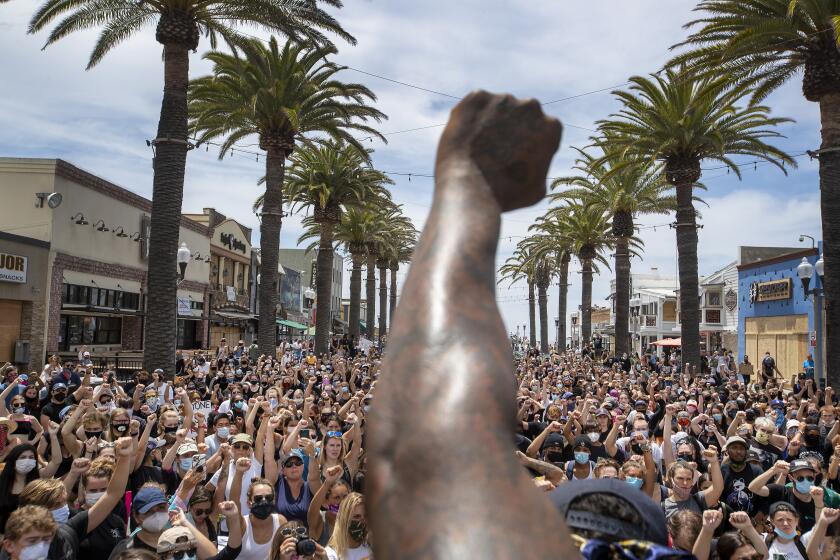Dana Spiotta’s novel of midlife female rage
- Share via
On the Shelf
Wayward
By Dana Spiotta
Knopf: 288 pages, $27
If you buy books linked on our site, The Times may earn a commission from Bookshop.org, whose fees support independent bookstores.
I’m 50 minutes into a conversation with Dana Spiotta, a National Book Award finalist and author of the new novel “Wayward,” before I bring up the question weighing on my mind: What’s that on the bookshelf next to her? I lean in closer, peering through my laptop into her home office in Syracuse, N.Y.
Spiotta grabs the mysterious object and shakes it before I realize what it is. “It’s the weirdest thing ever,” she says. “This is a baby rattle from the 1930s in the shape of a giant diamond ring. It’s Bakelite, or some kind of beautiful old plastic. And it’s got sparkles. It’s just everything that’s wrong with how we used to raise women — in one object. It’s so bad!” She laughs. “But it is kind of cool looking.”
Spiotta’s obsession with old plastic made its way into one of her earlier novels, “Eat the Document.” She shows me a broken children’s watch and a Harry Truman figurine. “There’s something poignant about these discarded old things,” she says. “And something whimsical about them too.”
The author of five novels, including “Stone Arabia” (“my real love letter to Los Angeles”), Spiotta spent her formative artistic years in Southern California, where her father ran Zoetrope, Francis Ford Coppola’s studio. To this collector of vintage plastic, the city is a whimsical assortment of highbrow and lowbrow.
“I love the sprawling landscape and all the contradictions it contains from architecture to geography to art,” she says. “The way it seems capacious to me, weird enough to accommodate eccentric experiments and alternative ways of living. Partly it reminds me of upstate New York.”
“Wayward” takes place in Syracuse, and even though the story mostly transpires in 2017, it’s infused with Spiotta’s fascination with history — in this case, 19th century reformist movements and specifically the Oneida Community, a perfectionist religious society formed in the area.
But most of all, “Wayward” is — defiantly, poignantly — a novel of middle age. Spiotta started the novel after Donald Trump defeated Hillary Clinton, a moment that crystallized for the author the sense that, as she wrote in a statement on her website, “the culture had no use for old women.” She often worked on “Wayward” during bouts of insomnia attributed to perimenopause and finished it in February 2020, just before the pandemic and the murder of George Floyd shifted the American terrain. Although shifted is the wrong word — more like fractured along cracks already visible and deep.
One of the many strengths of the novel is its unflinching portrayal of anger both personal and collective. There’s a pivotal chapter set at a law enforcement-themed state fair (based on a Great New York State Fair that Spiotta went to), featuring a butter sculpture of “two cops with holstered guns helping a kid milk a cow” and T-shirts with hateful slogans, “S—splattered hostility for its own sake.”
Then there is the personal story. Sam, a woman in her 50s, falls in love with an old Arts and Crafts cottage and buys it. “It was wrecked. It was hers,” Spiotta writes. It’s only after Sam purchases the house that she realizes she’s leaving behind her suburban life (and family). Her teenage daughter, Ally, opts to stay with her dad and give her mother the silent treatment. Ally has her own wayward secret to fixate on: a relationship with an older man.
Sam continues to receive financial support from her husband — and to sleep with him. She becomes aware of her privilege, especially after witnessing a racist police shooting near her home.
“If we’re going to understand where we are now, we have to understand where we come from,” Spiotta tells me. The book weaves between the stories of Sam and Ally, but it also includes an epistolary chapter from Clara Loomis, a problematic suffragist of Spiotta’s invention who advocated “controlled genetics” — and in whose historic home Sam now works. Clara’s story mirrors Ally’s in a way, also concerning a predatory relationship.
Walter Mosley, Luis Rodriguez, the coiner of #BlackLivesMatter and others sketch a hopeful future for L.A. and the U.S. after George Floyd protests.
“Wayward” isn’t autobiographical, but Spiotta was inspired by a house for sale a few blocks from her own — as well as by her experience with perimenopause.
“I think one of the things that always gets to me is self-delusion,” Spiotta says. “So my characters often have that, where they realize their own complicity, their own hypocrisy ratio. Sam is trying to be brave. And in some ways she is. But she’s stuck as well. That’s a big question for me: How do you change? Can you change? How do you have clarity about where you are? The older you get, the harder it is to change … a rupture has more consequences for everyone.”
Sam’s boldness manifests as rage at times — at other people, at the world she finds herself in, at herself. “It is real, and its expression is afforded to her by her hormones, but it has always been there,” Spiotta says. “There is a lot to be angry about. But her rage is outsize, often a little humiliating and misdirected. It feels out of control and it costs her a lot, physically and psychically. So it is a paradox — both good and bad.”
Something that struck me, reading the novel, was how insignificant the male characters are. It’s the women who are given time on the page. There’s a longing at the center of their relationships: a desire for a life of one’s own, but also the kind of intimate connection (or the lack of it) that comes with being a daughter and a mother. Sam’s mother is terminally ill, her daughter untethered from her. Sam “needs to let go of her tight grip on everyone, but particularly her mother, her daughter, and her fear of what is to come,” Spiotta says.
During one of the most moving scenes in the book, Sam watches a woman in her 60s help her adult special-needs daughter take a shower at the gym — and notes how easy and joyful they seem together.
“There is a lie in young fit bodies,” Spiotta writes. “There is something human — touching — in the older body, in its honest relationship to decay and time. Seeing the two women’s bodies, Sam felt a form of enchantment. To look, to behold, to abide age gave her an almost narcotic clarity; she could, for this moment, as long as it lasted, see and face what life really was.”
“Wayward” is about the pain of fleeting things — as when Sam observes tree blossoms whose “coming and going weighed on her and almost made it too painful to enjoy.” But it’s also about letting go of illusions and accepting the passage of time. It makes sense that its author surrounds herself with artifacts. Spiotta now shares her collecting hobby with her daughter.
Gina Frangello’s “Blow Your House Down” lives up to its title, openly chronicling her illness and messy divorce. She sees it as a radical feminist act.
Filgate is a writer and the editor of the anthology “What My Mother and I Don’t Talk About.”
More to Read
Sign up for our Book Club newsletter
Get the latest news, events and more from the Los Angeles Times Book Club, and help us get L.A. reading and talking.
You may occasionally receive promotional content from the Los Angeles Times.









